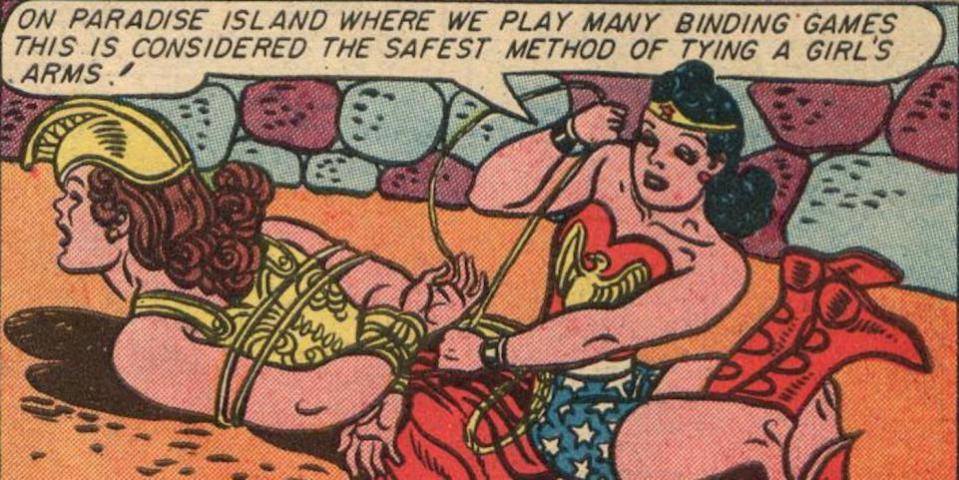'Wonder Women' Tells Creator's Kinky, Smart Love Story
There's a reason Wonder Woman binds her enemies with a golden lasso and proudly wears the "bracelets of submission." It's always been about sex, as the new biopic Professor Marston and the Wonder Women reveals.
Wonder Woman was created in the late 1930s by a psychologist, William Moulton Marston, his wife, Elizabeth, and their two girlfriends, Marjorie and Olive. Professor Marston, which is playing in select theaters now, ignores Marjorie, focusing instead on the sensual love story that flourished among William (Luke Evans), Elizabeth (Rebecca Hall) and Olive (Bella Heathcote), a graduate student whose writing on Marston inspired DC Comics to hire him as a writer.

Wonder Woman, who debuted in comics in 1941, was always a bit bizarre compared to superheroes like Superman and Batman. She didn't condone violence, chose diplomacy over warfare and generally seemed to enjoy intimate struggles with her (also female) villains. There's always been a great deal of queer imagery, BDSM imagery and first-wave feminism in the early Wonder Woman comics, but Professor Marston and the Wonder Women is the first to shine a light directly on the source of all that progressive thought.
The film has been well received by the queer community, who call it a sensitive portrayal of BDSM and polyamory. Elizabeth and Olive manage their sexual and romantic relationship as part of their collective, and they share each other with William as much he shares himself with both women. As in any polyamorous relationship, jealousies and miscommunications arise, but William, Elizabeth and Olive work their conflicts out, motivated by the conception of their art. All of them equally want to be loved by the others, and we see their vulnerability naked onscreen. It's an arresting experience, especially for those who have always considered themselves irrefutably monogamous.

The real Marston had a sense of humor about his sexual proclivities, stealthily placing images of women, both bound and binding each other, throughout Wonder Woman's comics. As we see in the film, those who recognized what Marston was suggesting were appalled, but Wonder Woman's love of bondage flew under the radar for generations of readers. Even now, with DC's blockbuster Wonder Woman hitting theaters and making millions, most don't realize that the same character has been allowed to pursue men and women in her comics for years. Grant Morrison's recent Wonder Woman comics allow her to joke about sex, enjoy the act of seduction and live a celebratory, kinky lifestyle. Greg Rucka, who writes the central Wonder Woman storyline, was the center of controversy when he wrote her bisexuality into the comics—though, as Rucka said to the press, anyone upset with the "development" hadn't been paying attention. Wonder Woman (and her alter ego, Diana Prince) had been queer from the start, and comic books had flown under the radar until superhero movies became big business.
Gal Gadot, who plays Wonder Woman in DC's film universe, told Variety she supported the idea that the character was queer, though she added that the films wouldn't explore it. "It never came to the table, but when you talk theoretically about all the women on Themyscira and how many years she was there, then what he said makes sense." When Gadot hosted Saturday Night Live in October, she starred in a sketch set on Wonder Woman's island of origin. Two butch-leaning lesbians, played by Aidy Bryant and Kate McKinnon (who actually is queer), show up on the island, assuming the Amazons are all queer. They're disappointed and comically confused when the Amazons, acting according to DC's plans for them, say they hadn't ever really thought about being with women.
The sketch launched a few headlines describing Gadot kissing McKinnon, but most critics ignored what it was really saying: that ignoring Wonder Woman's queer origins is beginning to look ridiculous in a world where queer issues are supposedly becoming mainstream. "Oh, come on," McKinnon's lesbian character deadpans in the sketch. "Seriously? None of you are gay? Not one?"
Critics will call Professor Marston a revelation, though the film doesn't introduce information that many fans of the character and her backstory haven't known all along: that kinkiness in sexual relationships doesn't have to happen to the detriment to emotional depth, and that monogamy isn't the ultimate goal for everyone. If anything, Professor Marston is a sexy unveiling of a badly kept secret. The polyamorous love story asks viewers to open themselves to a new, sensual possibility; it's what Diana Prince herself would want.
Related Articles


